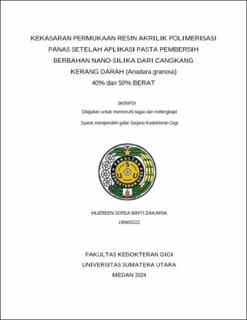| dc.description.abstract | Surface roughness of the denture base needs to be considered because abrasion easily occurs during cleaning, resulting in surface roughness of the denture base. The size of the silica particles in the cleaning paste determines how much surface roughness occurs on the denture base. Sources of silica can be obtained from natural materials such as blood clam shells (Anadara granosa). The aim of this research was to determine the difference in surface roughness of heat cured acrylic resin after application of cleaning paste made from nano-silica from blood clam shells (Anadara granosa) with the addition of 40% and 50% by weight of nano-silica. Nano-silica (54nm) from blood clam shells can be obtained using the sol-gel method. The research sample is a heat cured acrylic resin in the shape of a square with dimensions of 20x20x2 mm. A total of 30 samples were divided into three groups, namely without addition and addition of 40% and 50% nano-silica by weight. 1 g of denture cleaning paste was brushed onto the heat cured acrylic resin samples using an electric toothbrush with rotational movement for 18 minutes each day for 10 days. Then, surface roughness was tested before and after treatment using a profilometer. The average surface roughness results after application of cleaning paste in groups I, II, and III were 0,15 ± 0,02μm; 0,19 ± 0,02μm; 0,21 ± 0,04μm, respectively. The result of the One-Way ANOVA test for the final groups yielded a significant value of p = 0,002
< 0.05, indicating differences in surface roughness among the groups of cleaning paste. Post hoc LSD test showed that group I compared to II had a value of p = 0,018 (p < 0,05), group I compared to III had a value of p = 0,001 (p < 0,05), and group II compared to III had a value of p = 0,202 (p > 0,05). It can be concluded that heat cured acrylic resin shows differences in surface roughness after the application of control cleaning paste and cleaning paste containing 40% and 50% by weight of nano- silica from blood clam shells. There is also a significant difference in surface roughness between the control cleaning paste and cleaning paste containing 40% by weight of nano-silica, as well as between the control cleaning paste and cleaning paste containing 50% by weight of nano-silica. However, there doesn't appear to be a significant difference in surface roughness between the cleaning paste containing 40% by weight of nano-silica and the cleaning paste containing 50% by weight of nano- silica. | en_US |


